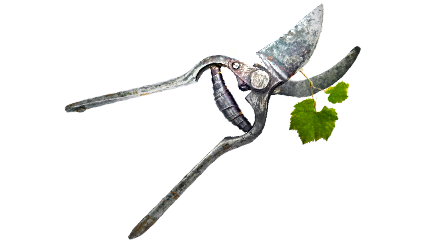Heritage transmission
Legend has it that the name Kitterlé, known before as Küterlé, comes from Kuter (a Swabia dialect) and means large wild tomcat. Before, this tomcat lived in «Haut Saering» and its malicious spirit would appear in the barrels of neighbouring castles. According to another version, Kitterlé was the name of a poor wine-maker from Guebwiller who was the first person to dare trying to plant vines on the hillside. Visibly, regardless the origin of the work, popular imagination has always praised the virtues of this terroir.
Kitterlé was continuously cultivated for over 10 centuries. This terroir, mentioned in 1699, has always had an exceptional reputation. During the Middle Ages, Guebwiller was administered by the despotic power of the Princes-Abbots of Murbach. Any nobles opposed to their power where run out of town, forcing the dissolution of the defiant bodies. During the 12th century, wine-making made Guebwiller one of the most important villages in Alsace. The growth area of (today Kessler Grand Cru), Saering and Kitterlé sent goods through Basel and Luzern to Austria. Their reputation was such that unscrupulous traders delivered wines to the Swiss claiming it was Guebwiller wine.
Au XVIIème, les Guebwillerois, pour déjouer l’action des trafiquants, décident d’apposer un certificat d’origine sur chaque tonneau de vin qui part de leurs caves. As witnessed by a missive sent from Guebwiller to the town of Luzern on April 15, 1667: We decided to write to these people in Luzern as we learned that some buyers are tempted to take wines from Rouffach, Westhalten and Soultzmatt to then sell them as Guebwiller wines so to inform you that from now on these wines will be accompanied by a Ladtzettel (or certificate of origin).» They therefore became precursors of «Appellations d’Origine Contrôlée» (Protected Designation of Origin). They therefore became precursors of Appellations d’Origine Contrôlée (Protected Designation of Origin).
During the 19th century, it can be read in the Haut Rhin administrative directory in 1854: are particularly well-known […] the lovely wines of Guebwiller, known under the name of Kitterlé, which can sometimes adopt a taste resembling rowan or hazel trees, which gave them the name of Eschgriessel and Hasselnusser. Wine from the same area made from the Ollwer grape, has the reputation of preventing lithiasis and it’s even said that this wine cures those affected by this illness.
La délibération du conseil municipal de Colmar (1837) apporte l’indication suivante : It is obvious that the Colmar wine-growing area located on the plain can be assimilated to those in the mountains … the schatz is old at barely 800 francs whereas in Guebwiller a schatz, which is 7 acres, is sold at 3000 francs. Products from the best wine-growing municipalities are highly superior in quantity and quality to those of the first-class ones of Colmar. Therefore we can expect estimations of the canton vineyards of Rouffach, Ribeauvillé and Guebwiller to be close to those of the bad plain-vineyard.
As the wine trade was suffering a bad period due to poor sales and lack of day labourers, Swiss and Mulhouse manufacture-owners bought out old ecclesiastic estates to set-up their textile factories. Many of them preferred working in the factories rather than continue being worn out on the slopes of the Ober or the Unterlinger. The arrival of downy mildew and phylloxera made the situation worse.
Les difficultés rencontrées par les vignerons sont une aubaine pour les nouveaux maîtres de la cité. This easily gave the impression of being respectable landowners: As G. Bischoff points out, Industrialists bought the best vineyards, starting with the good growth areas sold as national properties. . One of them, Nicolas Schlumberger, began his conquest by purchasing 20 hectares of vineyards in 1810. At the end of the19th century, he had 40. At the time, his estate was considered one of the largest of the region. Among his descendants are some deep-rooted wine-makers: Ernest Schlumberger, great grandson of Nicolas, undertook in 1910 the complete rebuilding of the Guebwiller wine-growing area. Fifteen years later, his regrouping of lands – (way before this concept was invented!)- was finished with the purchase of 2500 new parcels. The Schlumberger estate stretches over more than 130 hectares of vineyards. It is the largest in Alsace and one of the largest in France.
A new era thus began for the Florival vineyards. It was placed under the double banner of industrial capitalism and return to tradition. The parcels were regrouped to form homogeneous wholes, only having the best-suited grape varieties for the soil and climate. Fifty kilometres of backing walls were rebuilt or restored. The large pinkish sandstone walls which supported the Kitterlé terraces resembled protective ramparts of the garden of earthly delights .
Victor Canales
Synvira
Beloved vineyards and land
The Kitterlé Grand Cru wines are produced using integrated farming and respecting the environment. Residual weedkillers are not recommended. The yield is blocked at 55 hectolitres per hectare without either PLC (highest yield allowed per hectare) or chaptalisation.
The mentions Vendanges Tardives and Sélections de Grain Nobles are not used on Kitterlé Grands Crus.
The back label is recommended to define the wine sugar level (dry, sweet or dessert).

















